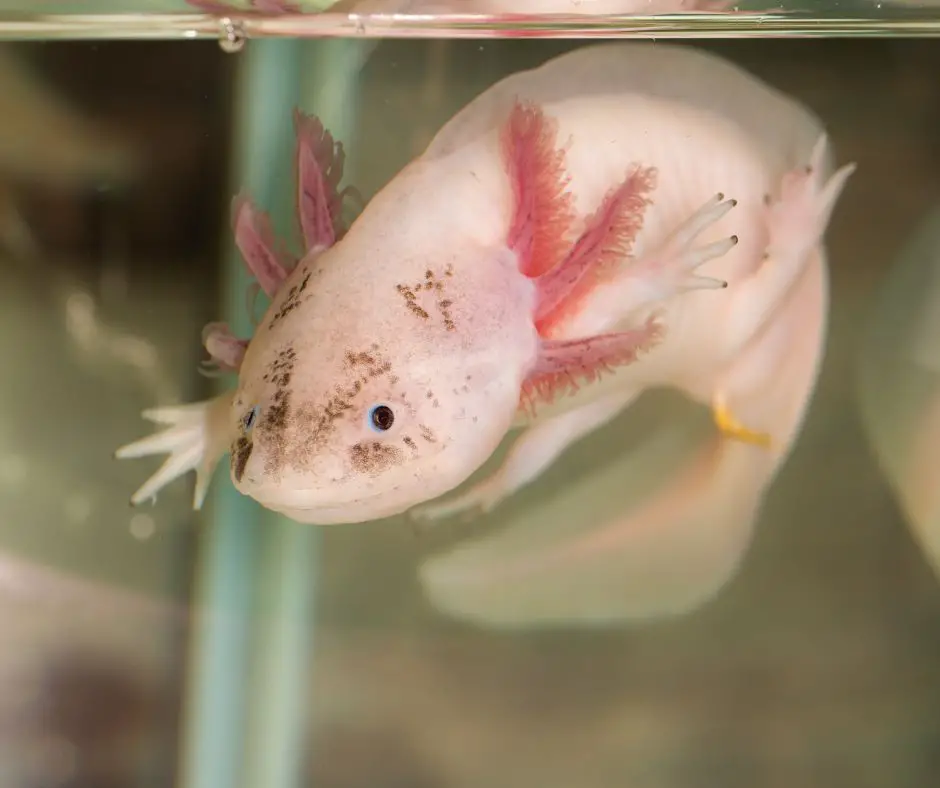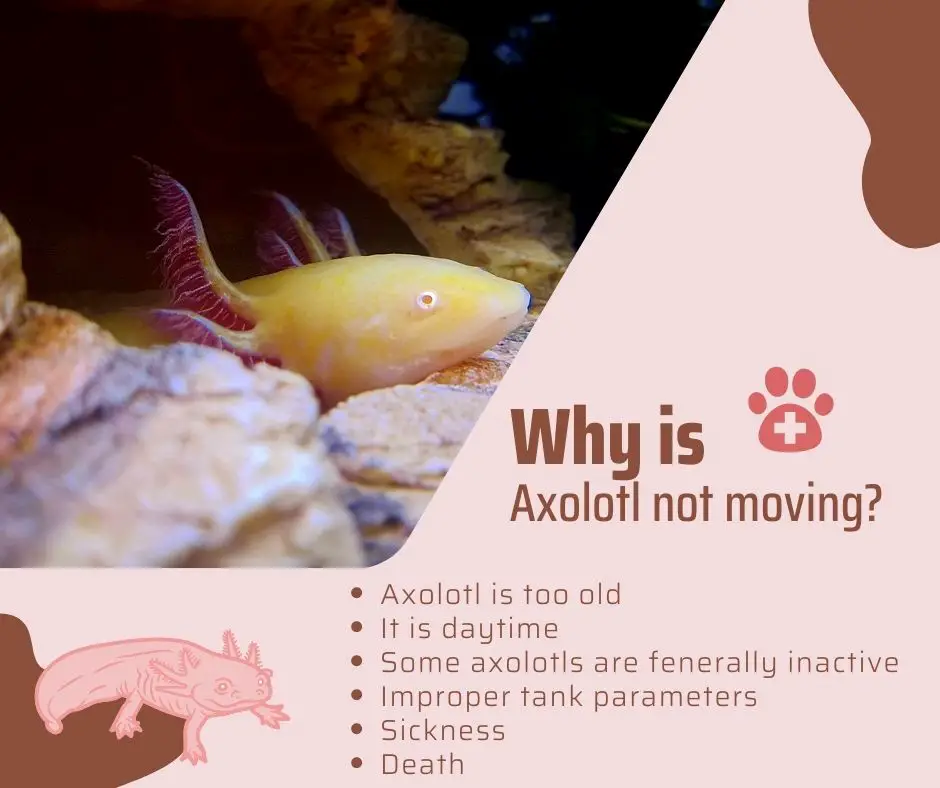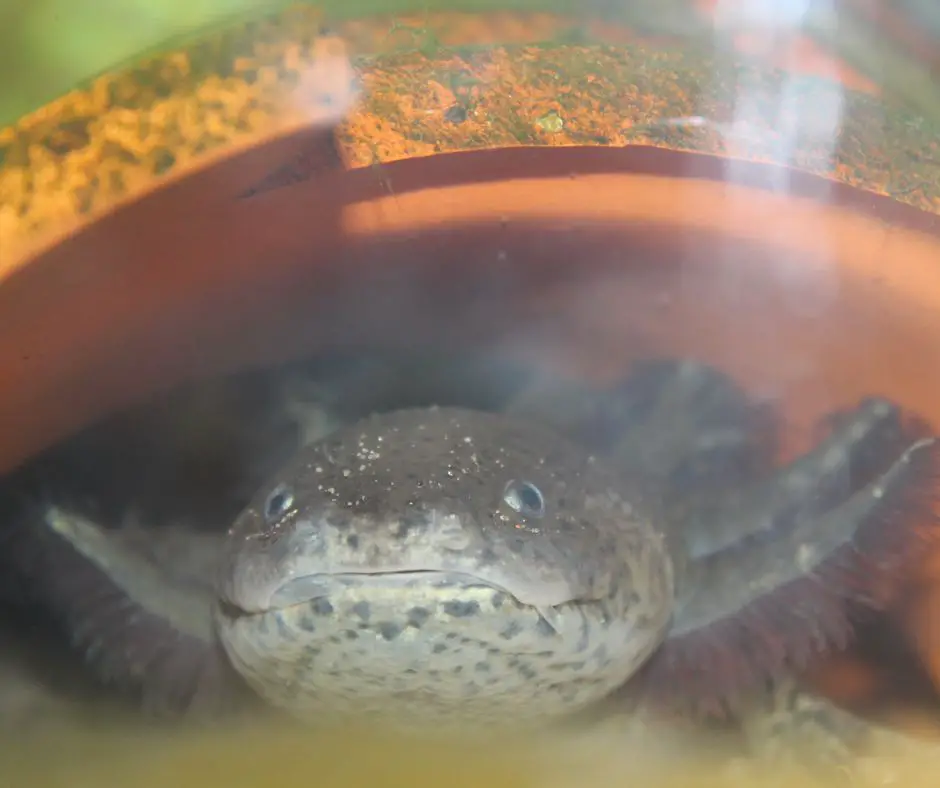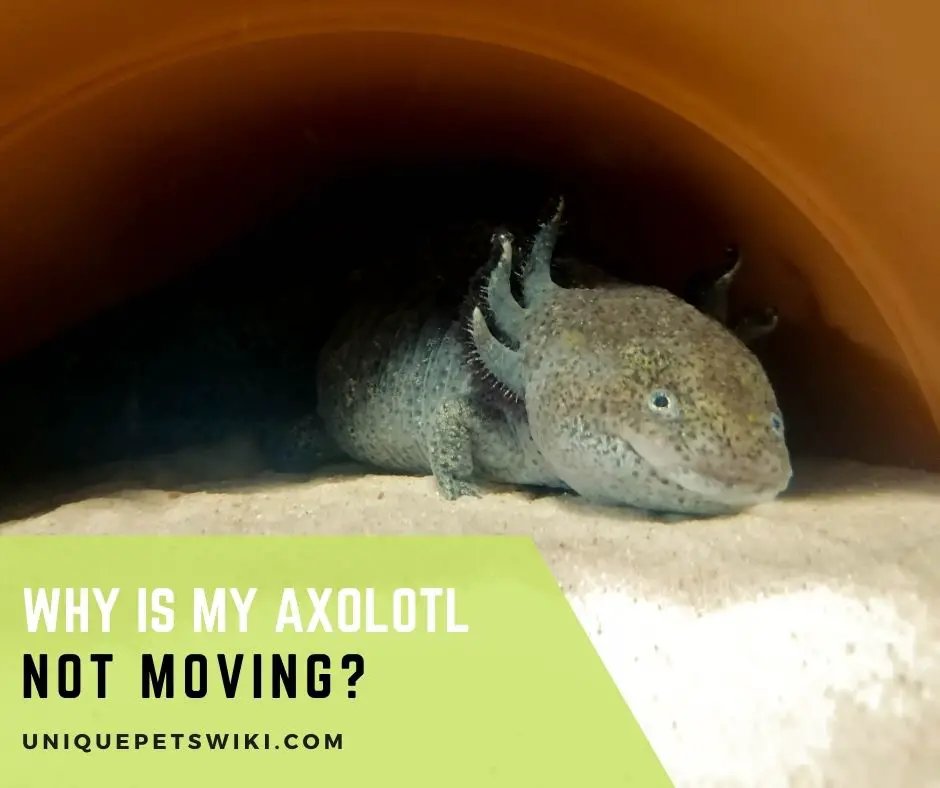Axolotls are cute salamanders known for their smiley faces. They make great pets since they are relatively easy to care for. They love to swim around their tanks and even come up to the surface or the walls to greet their owners.
Naturally, when a normally active axolotl suddenly becomes inactive and stops moving, it can be worrisome.
If you too are wondering ‘why is my axolotl not moving?’, then read on, this guide is for you.
Contents
How Much Should Axolotls Move?

Most Axolotls are fairly active creatures. When they are awake – normally at night – they like to swim around the tank.
They also love to swim in and out of their hidey-hole, caves, or rocks and pipes you may have provided. They sometimes even move the aquarium substrate or rocks that you have placed in the tank.
Axolotls are nocturnal creatures, so they tend to move more at night. You might find your axolotl is most active around dusk.
During the day, they become inactive. You might see your pet resting in its hideout or cave. Most axolotls rarely move during the daytime.
Some axolotls are simply more active than others. Of course, they also tend to slow down as they age; so an older axolotl might not swim around as much as it did in its youth.
Stress often makes axolotls move more than normal. A stressed axolotl will swim energetically, almost in a frenzy. A happy axolotl, on the other hand, is more likely to be calmer and might only move when it wants to feed or breed.
A new axolotl can also hide and move less. Basically, they need to adapt to a new tank.
Why Is My Axolotl Not Moving?
Most axolotls move quite a lot, especially during the night. If you suddenly find your pet inactive and immobile, the following reasons could be the cause:

It is too Old
An older axolotl usually won’t swim much. During the day, it will rest and sleep. At night too, it might simply lay in one position and only move when it wants to feed.
Axolotls, in captivity, live for around 10 years, although some have even been known to live for up to 20 years. An axolotl is considered ‘elderly’ or ‘senior’ by the time it is 8 years of age.
If you’re not sure of your axolotl’s age, you could try guessing it based on its length. A 4-inch axolotl is a juvenile. A teenaged axolotl measures about 6 inches in length. A fully-grown or adult axolotl is around 9 inches. Some axolotls have even been known to grow up to 18 inches!
So, if you have had your axolotl for several years now, and it has suddenly slowed down considerably, then it may be getting on in age. It does not have the energy it did in its youth which is why it may not move much.
It is daytime
Like all living creatures, axolotls need to rest and sleep. Also, like most tropical freshwater fish, axolotls are nocturnal so they rest during the day and feed at night. They tend to naturally get more active when it is dark. For the same reason, they dislike bright lights
Make sure you have placed your axolotl’s tank in a relatively dark place away from direct sunlight. Your pet could get stressed if the ambient light is too bright. Stress due to bright light might also force your pet to hide and not move much.
Some Axolotls Are Generally Inactive
If your axolotl has always been slow and inactive, then it could simply be a genetic predisposition. Most axolotls are active but some tend to be quite lazy.
Lazy axolotls prefer floating around the tank without doing anything. They may only move when it is time to eat or breed.
Some axolotls will be more active at night, so you might not see them move and swim around since you may be asleep while your pet moves around.
Improper Tank Parameters
Axolotls are delicate creatures and they need very specific water conditions. If the water is very cold, they may become inactive to conserve energy.
Remember: axolotls need their water temperature between 16-18 deg C or 60-64 F. Very cold water may be the reason your axolotl is not moving.
Some axolotls remain floating with their butt facing upwards – a phenomenon that is commonly seen in juvenile axolotls that have swallowed too much air or developed an air bubble in their belly.
If your axolotl is not moving and seems tilted on one side or off-balance, then its water may be too warm. Axolotls sometimes remain afloat on their sides if there is excess ammonia or the water temperature is off.
Occasional inactivity is normal in axolotls but if your pet continues to remain still, you may want to check all the water parameters.
API 5-in-1 Test Strips Freshwater and Saltwater Aquarium Test Strips
- Contains one (1) API 5-IN-1 TEST STRIPS Freshwater and Saltwater Aquarium Test Strips 25-Count Box
- Monitors levels of pH, nitrite, nitrate carbonate and general water hardness in freshwater and saltwater aquariums
- Dip test strips into aquarium water and check colors for fast and accurate results
- Helps prevent invisible water problems that can be harmful to fish and cause fish loss
- Use for weekly monitoring and when water or fish problems appear
Last update on 2022-12-30 / Affiliate links / Images from Amazon Product Advertising API
Sickness
Another reason why an axolotl is not moving is due to ill-health. A number of health issues can cause an axolotl to become inactive and stop swimming.
For example, a constipated axolotl that is unable to poop will stop eating and swimming and might simply float on the surface.
Impaction is another serious health issue that can result in immobility in axolotls. An impacted axolotl will float on the surface of the water and may stop feeding for several days.
In both cases, you could try fridging your axolotl. Fridging involves transferring your axolotl in a container filled with cold, dechlorinated water. The cold water stimulates bowel movement so your pet can poop.
In serious cases, an impacted axolotl may need surgery to remove the blockage.
Sistema 1850 Klip It Collection Rectangle Food Storage Container, 169 Ounce/21 Cup
- Extra-large food storage container ideal for a variety of foods and ingredients
- Lid with easy-locking clips and extended flexible seal helps keep food fresher for longer
- Modular stacking design and rectangular shape helps save valuable space
- 100% virgin plastic; phthalate- and BPA-free
- Top-rack dishwasher-safe; fridge- and freezer-safe; microwave-safe without lid
Last update on 2022-12-29 / Affiliate links / Images from Amazon Product Advertising API
Death
Finally, the most obvious reason why an axolotl is not moving at all is if it has died suddenly. This can be shocking but it is known to happen.
Various factors can cause sudden death in axolotl. Mostly, it is due to improper water conditions.
Here are some signs that an axolotl is dead:
- Laying very still – not swimming at all
- Its gills might still move
- If you touch it, there is absolutely no response or movement at all.
- Its food will remain uneaten in the tank
You could check if your axolotl’s heart is still beating. Axolotl heartbeat can be felt through its skin because they have very thin translucent skin. If its heart is not beating, your axolotl is probably dead.
Axolotl Not Moving and Related Problems
Sometimes axolotls may not move at all and at other times, they might move a lot. In any case, you need not panic. Most axolotls self-regulate. As long as your pet is eating normally, you need not worry. Here are some other axolotl issues linked to mobility:

Axolotl Swimming too Much
Your pet is clearly stressed. It is an indication that the water parameters are off. Usually, bad water is the reason why an axolotl might swim in an energetic frenzy.
Axolotls too Active
A crashed nitrogen cycle, water pH higher than 6.7, or an overly powerful filter could make your axolotl hyperactive.
Axolotl is Holding Still
Mostly it is resting. If it is daytime your axolotl is probably asleep. Disease, improper water parameters, and a crashed cycle can also cause immobility in axolotls.
Final Verdict- Why Is My Axolotl Not Moving?
There are several reasons that could cause an axolotl to stop moving: it may simply be sleeping or resting (usually during the day), or it might have become old.
Sometimes, improper water parameters like ammonia, pH, nitrates, nitrites, and temperature, may cause your pet to become dull and inactive. Sickness or ill-health is also one of the factors behind inactivity in axolotls.
We hope this guide helps you address the question ‘why is my axolotl not moving?’ and also find the solution.


